Spring Boot基于Redisson实现Redis分布式可重入锁源码详解
收藏
大家好,我们又见面了啊~本文《Spring Boot基于Redisson实现Redis分布式可重入锁源码详解》的内容中将会涉及到等等。如果你正在学习数据库相关知识,欢迎关注我,以后会给大家带来更多数据库相关文章,希望我们能一起进步!下面就开始本文的正式内容~
一、前言
我们在实现使用Redis实现分布式锁,最开始一般使用SET resource-name anystring NX EX max-lock-time进行加锁,使用Lua脚本保证原子性进行实现释放锁。这样手动实现比较麻烦,对此Redis官网也明确说Java版使用Redisson来实现。小编也是看了官网慢慢的摸索清楚,特写此记录一下。从官网到整合Springboot到源码解读,以单节点为例。
二、为什么使用Redisson
1. 我们打开官网
redis中文官网
2. 我们可以看到官方让我们去使用其他
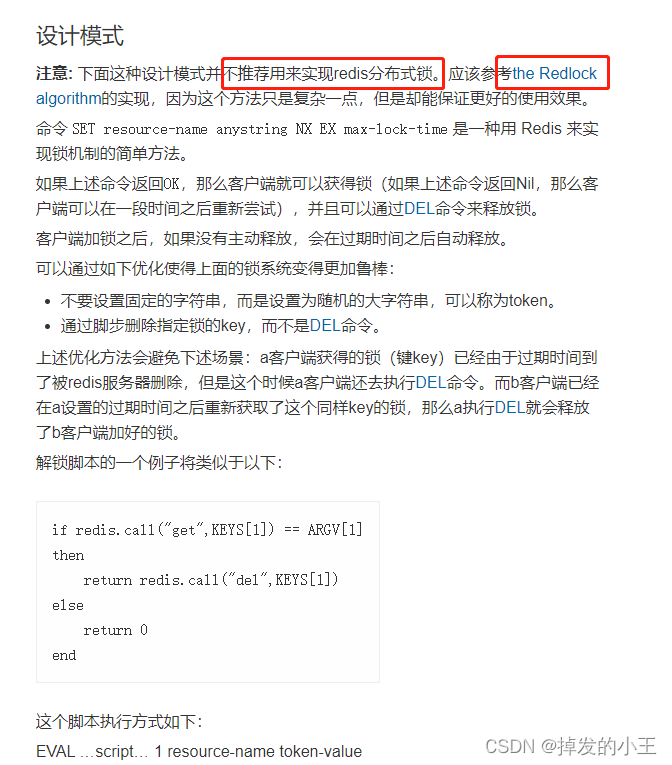
3. 打开官方推荐
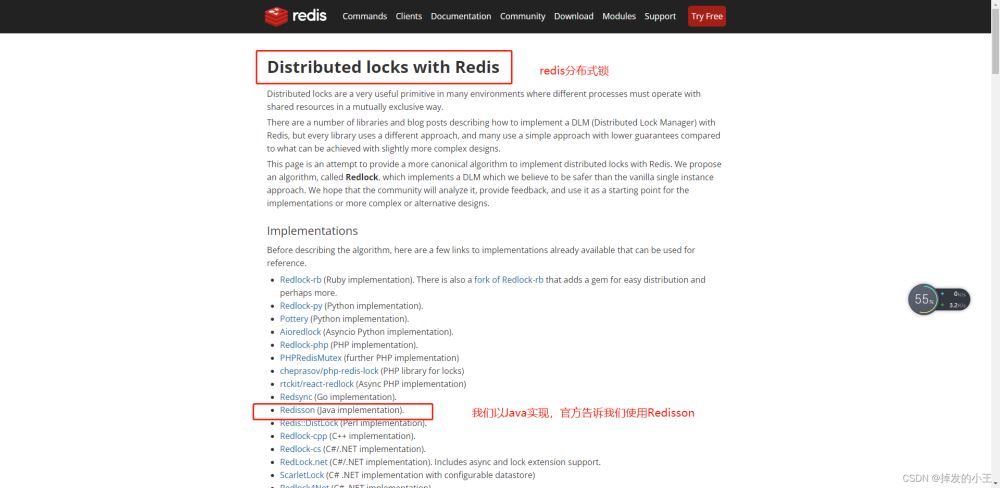
4. 找到文档
Redisson地址
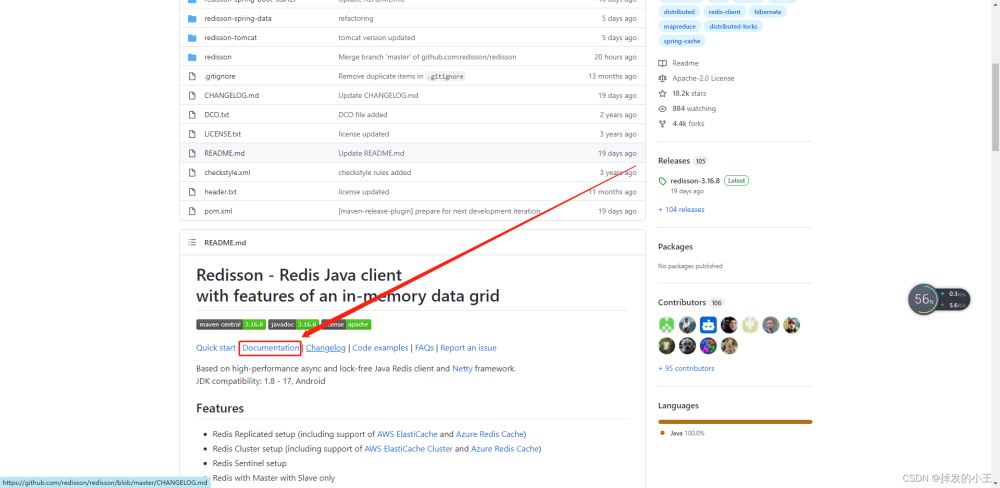
5. Redisson结构
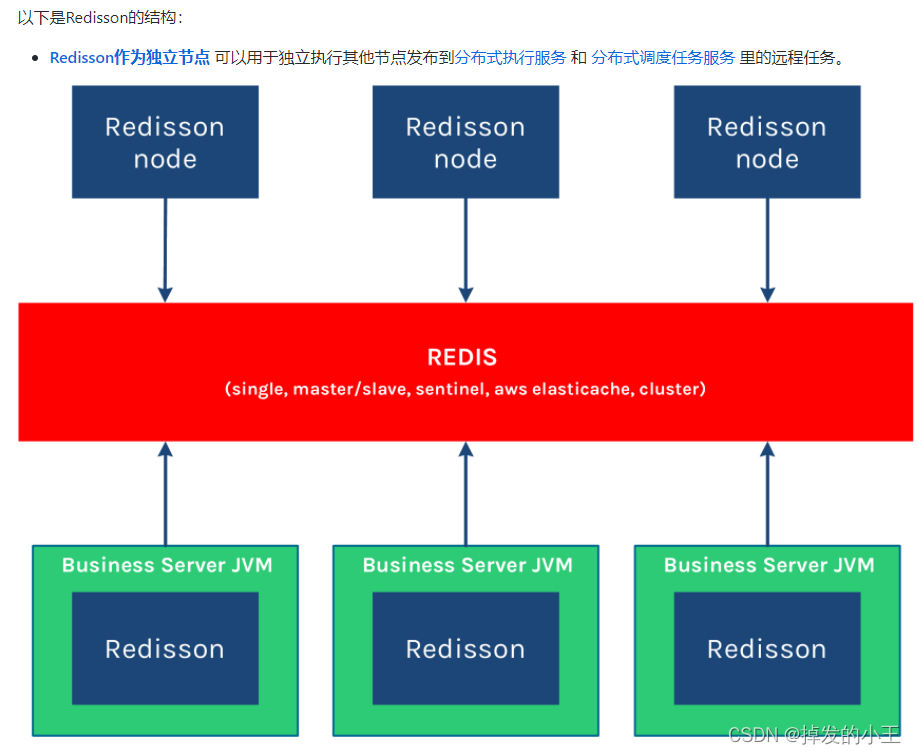
三、Springboot整合Redisson
1. 导入依赖
org.springframework.boot
spring-boot-starter-data-redis
redis.clients
jedis
org.redisson
redisson
3.12.0
2. 以官网为例查看如何配置

3. 编写配置类
import org.redisson.Redisson;
import org.redisson.api.RedissonClient;
import org.redisson.config.Config;
import org.springframework.context.annotation.Bean;
import org.springframework.context.annotation.Configuration;
/**
* @author wangzhenjun
* @date 2022/2/9 9:57
*/
@Configuration
public class MyRedissonConfig {
/**
* 所有对redisson的使用都是通过RedissonClient来操作的
* @return
*/
@Bean(destroyMethod="shutdown")
public RedissonClient redisson(){
// 1. 创建配置
Config config = new Config();
// 一定要加redis://
config.useSingleServer().setAddress("redis://192.168.17.130:6379");
// 2. 根据config创建出redissonClient实例
RedissonClient redissonClient = Redisson.create(config);
return redissonClient;
}
}
4. 官网测试加锁例子
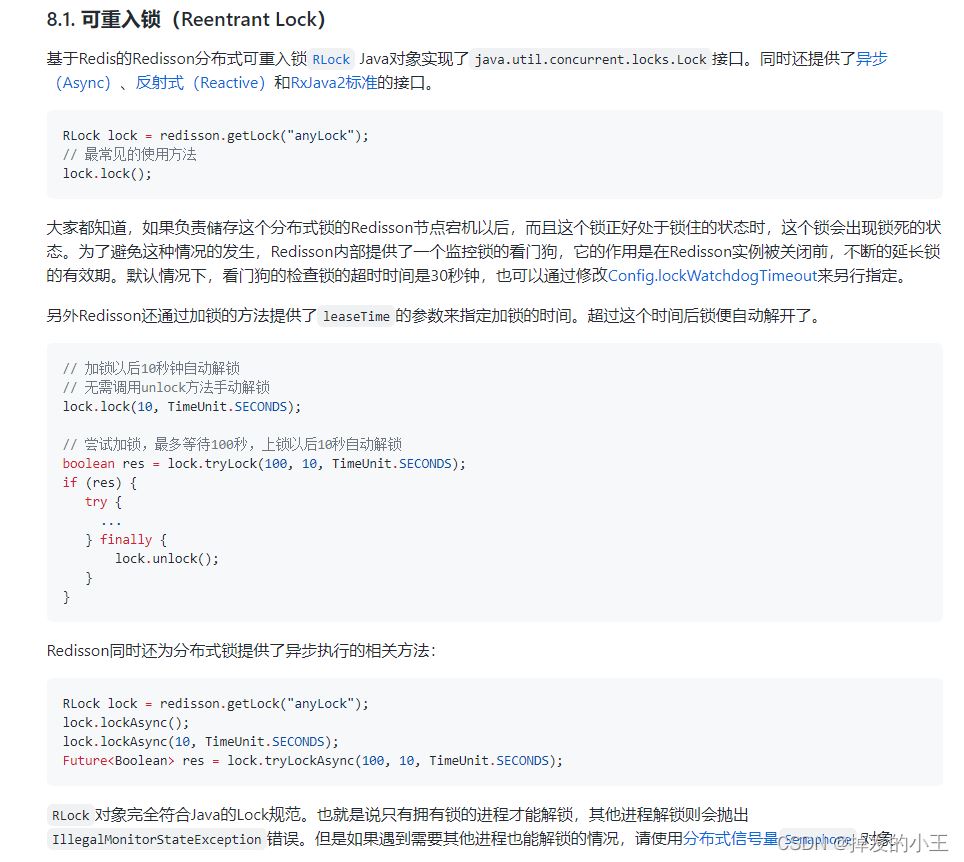
5. 根据官网简单Controller接口编写
@ResponseBody
@GetMapping("/hello")
public String hello(){
// 1.获取一把锁,只要锁名字一样,就是同一把锁
RLock lock = redisson.getLock("my-lock");
// 2. 加锁
lock.lock();// 阻塞试等待 默认加的都是30s
// 带参数情况
// lock.lock(10, TimeUnit.SECONDS);// 10s自动解锁,自动解锁时间一定要大于业务的执行时间。
try {
System.out.println("加锁成功" + Thread.currentThread().getId());
Thread.sleep(30000);
} catch (InterruptedException e) {
e.printStackTrace();
} finally {
// 3. 解锁
System.out.println("解锁成功:" + Thread.currentThread().getId());
lock.unlock();
}
return "hello";
}
6. 测试
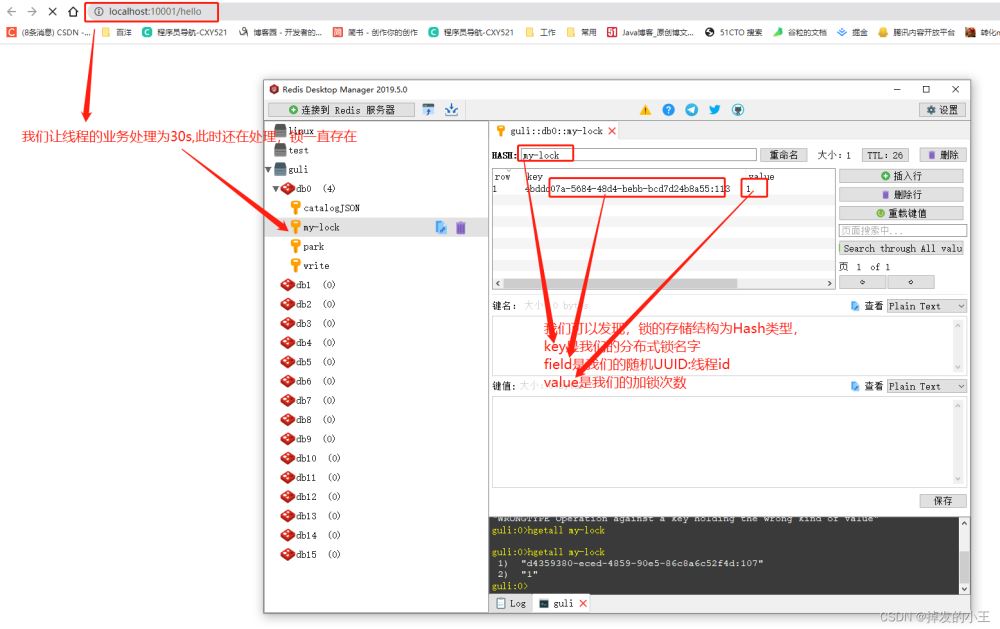
四、lock.lock()源码分析
1. 打开RedissonLock实现类

2. 找到实现方法
@Override
public void lock() {
try {
// 我们发现不穿过期时间源码默认过期时间为-1
lock(-1, null, false);
} catch (InterruptedException e) {
throw new IllegalStateException();
}
}
3. 按住Ctrl进去lock方法
private void lock(long leaseTime, TimeUnit unit, boolean interruptibly) throws InterruptedException {
// 获取线程的id,占有锁的时候field的值为UUID:线程号id
long threadId = Thread.currentThread().getId();
// 尝试获得锁
Long ttl = tryAcquire(leaseTime, unit, threadId);
// lock acquired 获得锁,返回
if (ttl == null) {
return;
}
// 这里说明获取锁失败,就通过线程id订阅这个锁
RFuture
future = subscribe(threadId);
if (interruptibly) {
commandExecutor.syncSubscriptionInterrupted(future);
} else {
commandExecutor.syncSubscription(future);
}
try {
// 这里进行自旋,不断尝试获取锁
while (true) {
// 继续尝试获取锁
ttl = tryAcquire(leaseTime, unit, threadId);
// lock acquired 获取成功
if (ttl == null) {
// 直接返回,挑出自旋
break;
}
// waiting for message 继续等待获得锁
if (ttl >= 0) {
try {
future.getNow().getLatch().tryAcquire(ttl, TimeUnit.MILLISECONDS);
} catch (InterruptedException e) {
if (interruptibly) {
throw e;
}
future.getNow().getLatch().tryAcquire(ttl, TimeUnit.MILLISECONDS);
}
} else {
if (interruptibly) {
future.getNow().getLatch().acquire();
} else {
future.getNow().getLatch().acquireUninterruptibly();
}
}
}
} finally {
// 取消订阅
unsubscribe(future, threadId);
}
// get(lockAsync(leaseTime, unit));
}
4. 进去尝试获取锁方法

private Long tryAcquire(long leaseTime, TimeUnit unit, long threadId) {
// 直接进入异步方法
return get(tryAcquireAsync(leaseTime, unit, threadId));
}
private
RFuture
tryAcquireAsync(long leaseTime, TimeUnit unit, long threadId) { // 这里进行判断如果没有设置参数leaseTime = -1 if (leaseTime != -1) { return tryLockInnerAsync(leaseTime, unit, threadId, RedisCommands.EVAL_LONG); } // 此方法进行获得锁,过期时间为看门狗的默认时间 // private long lockWatchdogTimeout = 30 * 1000;看门狗默认过期时间为30s // 加锁和过期时间要保证原子性,这个方法后面肯定调用执行了Lua脚本,我们下面在看 RFuture
ttlRemainingFuture = tryLockInnerAsync(commandExecutor.getConnectionManager().getCfg().getLockWatchdogTimeout(), TimeUnit.MILLISECONDS, threadId, RedisCommands.EVAL_LONG); // 开启一个定时任务进行不断刷新过期时间 ttlRemainingFuture.onComplete((ttlRemaining, e) -> { if (e != null) { return; } // lock acquired 获得锁 if (ttlRemaining == null) { // 刷新过期时间方法,我们下一步详细说一下 scheduleExpirationRenewal(threadId); }); return ttlRemainingFuture;
5. 查看tryLockInnerAsync()方法
RFuture
tryLockInnerAsync(long leaseTime, TimeUnit unit, long threadId, RedisStrictCommand
command) { internalLockLeaseTime = unit.toMillis(leaseTime); return commandExecutor.evalWriteAsync(getName(), LongCodec.INSTANCE, command, // 首先判断锁是否存在 "if (redis.call('exists', KEYS[1]) == 0) then " + // 存在则获取锁 "redis.call('hset', KEYS[1], ARGV[2], 1); " + // 然后设置过期时间 "redis.call('pexpire', KEYS[1], ARGV[1]); " + "return nil; " + "end; " + // hexists查看哈希表的指定字段是否存在,存在锁并且是当前线程持有锁 "if (redis.call('hexists', KEYS[1], ARGV[2]) == 1) then " + // hincrby自增一 "redis.call('hincrby', KEYS[1], ARGV[2], 1); " + // 锁的值大于1,说明是可重入锁,重置过期时间 "redis.call('pexpire', KEYS[1], ARGV[1]); " + "return nil; " + "end; " + // 锁已存在,且不是本线程,则返回过期时间ttl "return redis.call('pttl', KEYS[1]);", Collections.
singletonList(getName()), internalLockLeaseTime, getLockName(threadId)); }
6. 进入4留下的定时任务scheduleExpirationRenewal()方法
一步步往下找源码:scheduleExpirationRenewal —>renewExpiration
根据下面源码,定时任务刷新时间为:internalLockLeaseTime / 3,是看门狗的1/3,即为10s刷新一次
private void renewExpiration() {
ExpirationEntry ee = EXPIRATION_RENEWAL_MAP.get(getEntryName());
if (ee == null) {
return;
}
Timeout task = commandExecutor.getConnectionManager().newTimeout(new TimerTask() {
@Override
public void run(Timeout timeout) throws Exception {
ExpirationEntry ent = EXPIRATION_RENEWAL_MAP.get(getEntryName());
if (ent == null) {
return;
}
Long threadId = ent.getFirstThreadId();
if (threadId == null) {
return;
}
RFuture
future = renewExpirationAsync(threadId);
future.onComplete((res, e) -> {
if (e != null) {
log.error("Can't update lock " + getName() + " expiration", e);
return;
}
if (res) {
// reschedule itself
renewExpiration();
}
});
}
}, internalLockLeaseTime / 3, TimeUnit.MILLISECONDS);
ee.setTimeout(task);
}
五、lock.lock(10, TimeUnit.SECONDS)源码分析
1. 打开实现类
@Override
public void lock(long leaseTime, TimeUnit unit) {
try {
// 这里的过期时间为我们输入的10
lock(leaseTime, unit, false);
} catch (InterruptedException e) {
throw new IllegalStateException();
}
}
2. 方法lock()实现展示,同三.3源码
3. 直接来到尝试获得锁tryAcquireAsync()方法
private
RFuture
tryAcquireAsync(long leaseTime, TimeUnit unit, long threadId) { // 这里进行判断如果没有设置参数leaseTime = -1,此时我们为10 if (leaseTime != -1) { // 来到此方法 return tryLockInnerAsync(leaseTime, unit, threadId, RedisCommands.EVAL_LONG); } // 此处省略后面内容,前面以详细说明。。。。 }
4. 打开tryLockInnerAsync()方法
我们不难发现和没有传过期时间的方法一样,只不过leaseTime的值变了。
RFuture
tryLockInnerAsync(long leaseTime, TimeUnit unit, long threadId, RedisStrictCommand
command) { internalLockLeaseTime = unit.toMillis(leaseTime); return commandExecutor.evalWriteAsync(getName(), LongCodec.INSTANCE, command, // 首先判断锁是否存在 "if (redis.call('exists', KEYS[1]) == 0) then " + // 存在则获取锁 "redis.call('hset', KEYS[1], ARGV[2], 1); " + // 然后设置过期时间 "redis.call('pexpire', KEYS[1], ARGV[1]); " + "return nil; " + "end; " + // hexists查看哈希表的指定字段是否存在,存在锁并且是当前线程持有锁 "if (redis.call('hexists', KEYS[1], ARGV[2]) == 1) then " + // hincrby自增一 "redis.call('hincrby', KEYS[1], ARGV[2], 1); " + // 锁的值大于1,说明是可重入锁,重置过期时间 "redis.call('pexpire', KEYS[1], ARGV[1]); " + "return nil; " + "end; " + // 锁已存在,且不是本线程,则返回过期时间ttl "return redis.call('pttl', KEYS[1]);", Collections.
singletonList(getName()), internalLockLeaseTime, getLockName(threadId)); }
六、lock.unlock()源码分析
1. 打开方法实现
@Override
public void unlock() {
try {
// 点击进入释放锁方法
get(unlockAsync(Thread.currentThread().getId()));
} catch (RedisException e) {
if (e.getCause() instanceof IllegalMonitorStateException) {
throw (IllegalMonitorStateException) e.getCause();
} else {
throw e;
}
}
// Future
future = unlockAsync();
// future.awaitUninterruptibly();
// if (future.isSuccess()) {
// return;
// }
// if (future.cause() instanceof IllegalMonitorStateException) {
// throw (IllegalMonitorStateException)future.cause();
// }
// throw commandExecutor.convertException(future);
}
2. 打开unlockAsync()方法
@Override
public RFuture
unlockAsync(long threadId) {
RPromise
result = new RedissonPromise
(); // 解锁方法,后面展开说 RFuture
future = unlockInnerAsync(threadId); // 完成 future.onComplete((opStatus, e) -> { if (e != null) { // 取消到期续订 cancelExpirationRenewal(threadId); // 将这个未来标记为失败并通知所有人 result.tryFailure(e); return; } // 状态为空,说明解锁的线程和当前锁不是同一个线程 if (opStatus == null) { IllegalMonitorStateException cause = new IllegalMonitorStateException("attempt to unlock lock, not locked by current thread by node id: " + id + " thread-id: " + threadId); result.tryFailure(cause); return; } cancelExpirationRenewal(threadId); result.trySuccess(null); }); return result; }
3. 打开unlockInnerAsync()方法
protected RFuture
unlockInnerAsync(long threadId) {
return commandExecutor.evalWriteAsync(getName(), LongCodec.INSTANCE, RedisCommands.EVAL_BOOLEAN,
// 判断释放锁的线程和已存在锁的线程是不是同一个线程,不是返回空
"if (redis.call('hexists', KEYS[1], ARGV[3]) == 0) then " +
"return nil;" +
"end; " +
// 释放锁后,加锁次数减一
"local counter = redis.call('hincrby', KEYS[1], ARGV[3], -1); " +
// 判断剩余数量是否大于0
"if (counter > 0) then " +
// 大于0 ,则刷新过期时间
"redis.call('pexpire', KEYS[1], ARGV[2]); " +
"return 0; " +
"else " +
// 释放锁,删除key并发布锁释放的消息
"redis.call('del', KEYS[1]); " +
"redis.call('publish', KEYS[2], ARGV[1]); " +
"return 1; "+
"end; " +
"return nil;",
Arrays.
asList(getName(), getChannelName()), LockPubSub.UNLOCK_MESSAGE, internalLockLeaseTime, getLockName(threadId)); }

